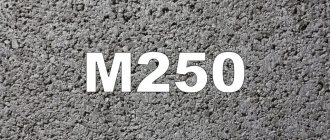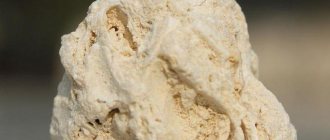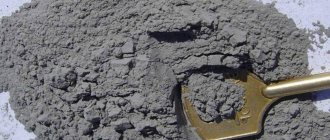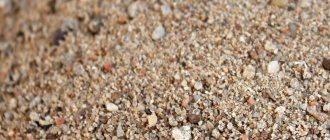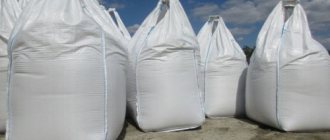Rough construction work is performed using less expensive materials compared to finishing installation. One of them is lean concrete. Compared to other similar mixtures, it has the property of slow hardening, allowing it to be transported over long distances. Manufacturing technologies are simple, making it possible to connect components immediately on the construction site, which saves construction time and resources.
Lean concrete is a mixture of binders, in particular cement, fillers, sand and water, compacted by rolling. Crushed stone and various plasticizers are used as fillers. Mixing is possible directly at the construction site.
The material got its name due to the small percentage of binder it contains. It differs from fatty and normal concrete in the proportions of its constituent components.
It is a dense, strong, rigid mass that can withstand heavy loads. It has restrictions on use, since exceeding standard values can lead to cracks and deformation. Suitable for subfloors, road cushions, paving slabs.
Skinny concrete - what is it?
All concretes are divided into three categories - skinny, standard, fat. Lean ones differ from the rest in their low concentration of binder components (cement) and high content of fillers. This ratio makes it possible to obtain solutions of increased rigidity, which combine complete homogeneity and easy installation using vibrating plates or rollers.
The production of the material is due to the fact that not all construction industries consider it advisable to use fatty solutions. For many jobs, it is sufficient to use concrete mixtures that meet the requirements of strength and frost resistance, but do not increase the cost of the final product.
Transportation Features
The most cost-effective and simplest method of transportation is transportation using a dump truck, due to the long setting time of the solution. During transportation, it is very important to ensure the correct temperature and humidity conditions to protect the concrete from excessive waterlogging or drying out. If the conditions are not met, the quality of the building material may deteriorate.
It is best to order ready-mixed concrete from manufacturers, as they maintain precise proportions of components using automatic weighing. When mixing the ingredients, special mixers are used that have a continuous or cyclic mixing action. To obtain a homogeneous mixture without delamination, concrete mixers are equipped with storage hoppers.
Brands of lean concrete
In construction, there are 5 grades of lean concrete, which differ in class, technical parameters, and area of application.
| Brand | Class | Characteristics |
| M200 | B15 | It has parameters close to those of heavy concrete and can be used for foundations and floors. |
| M150 | AT 10 | It has sufficient strength and a long service life, suitable for screeding or increasing soil stability. |
| M100 | B7.5 | A mortar with low strength parameters is used for work that does not require increased resistance of concrete to loads. |
| M75 | They have an extremely limited scope of application. | |
| M50 | B3.5 | — |
Recommendations
In modern construction, many types of concrete are used, each with its own characteristics. First, you should learn about lightweight types of concrete, namely, what expanded clay concrete and aerated concrete are.
- Autoclaved aerated concrete blocks are a mixture of concrete processed in autoclaves at high temperature and pressure. The end result is a durable, high-quality and reliable material made from environmentally friendly raw materials.
- Expanded clay concrete for flooring is characterized by low weight, sufficient strength, and increased thermal insulation and sound insulation qualities. With the listed advantages, it has a low price. The proportions of expanded clay concrete for screeds and floors are determined individually, taking into account the load on the base.
Concrete structures are prone to destruction in the absence of a metal base. Metal mesh for concrete reinforcement will increase the durability and strength of the structure.
A new type of concrete with fiber reinforcement is fiber-reinforced concrete. It is easier to consider what fiber-reinforced concrete is when determining its technical characteristics. With a low weight, it has relatively high strength, since reinforcing fiber or fiber is added to the composition.
Composition and main components
If we look at lean concrete in detail - what kind of substance it is, it is worth paying attention to the main components of the material. The structure of the mixture includes several components:
- binders (Portland or slag cement grade M300 and higher);
- medium or fine sand;
- fillers (most often crushed stone);
- purified water.
Based on the aggregates used, the material can be fine-grained or coarse-grained. In the first case, the dimensions of the crushed stone do not exceed 5 mm, in the second - they can reach 35–40 mm. Experts do not recommend using a larger fraction of filler, since during installation there is a high probability of deterioration in the stability of the solution.
The ratio of components in the mixture depends on the type of cement used, the degree of porosity of the crushed stone and the requirements for the strength of the finished concrete surface. The table below shows the approximate proportions of the components.
| Brand of lean concrete | Cement M400, kg | Crushed stone, kg | Sand, kg |
| M100 | 10 | 61 | 41 |
| M150 | 10 | 50 | 32 |
| M200 | 10 | 42 | 25 |
Manufacturing
Aerated concrete blocks
Concrete is produced by mixing cement, sand, crushed stone and water (their ratio depends on the brand of cement, fraction and moisture content of sand and crushed stone), as well as a small amount of additives (plasticizers, water repellents, etc.). Cement and water are the main binding components in the production of concrete. For example, when using 400 grade cement to produce 200 grade concrete, the ratio is 1:3:5:0.5. If grade 500 cement is used, then this conventional ratio produces concrete grade 350. The ratio of water and cement (“water-cement ratio”, “water-cement module”; denoted “W/C”) is an important characteristic of concrete. The strength of concrete directly depends on this ratio: the lower the W/C, the stronger the concrete. Theoretically, W/C = 0.2 is sufficient for cement hydration, but such concrete has too low plasticity, so in practice W/C = 0.3–0.5 are used.
A common mistake in artisanal concrete production is excessive addition of water, which increases the mobility of concrete, but reduces its strength several times.
Specifications
When figuring out what lean concrete means, you can determine the characteristic differences of the material by the technical characteristics of the manufactured coating. Its properties are regulated by GOST 25192-2012. According to the accepted standard, the mixture has the following parameters:
- compressive strength – from 75 to 250 MPa;
- density – from 2450 to 2500 kg/m3;
- mobility – from 10 to 15 cm;
- frost resistance – in the range of 50–100 freezing/defrosting cycles;
- hardness – from 90 to 120 s.
Due to the reduced strength, the mixtures are compacted using a roller or vibrating plate. This allows you to increase the density of the material, increase the adhesion of components, and remove excess air. The compaction coefficient during such work should average from 0.98 to 1.
Price for 1 m3 of different brands
The cost is determined by the characteristics of the brand. You can purchase material with delivery in various online stores. Approximate prices for gravel-based concrete:
- M100 - 2700-3150 rub.
- M150 - 2800-3400 rub.
- M200 - 2900-3500 rub.
- M250 - 3000-3500 rub.
Prices for 1 cubic meter concrete mix based on granite is slightly lower than that based on gravel. The average difference is from 100 to 160 rubles. per 1 cubic meter
When carrying out construction in winter, it is necessary to separately purchase anti-frost additives; their cost ranges from 150 to 350 rubles. depending on the brand.
Scope of application
The low strength of lean concrete partially limits their scope of application. Most often, the material is used in road construction for the construction of multilayer coatings. It serves as the base for the road surface and allows you to strengthen the upper layers of the road being built. In addition, mixtures can be used in the construction of buildings for the following purposes:
- forming a cushion for a monolithic or prefabricated foundation;
- subfloor installation;
- increasing soil stability during landscaping;
- foundation construction for swimming pools and similar structures;
- filling the cavities of blocks intended for the construction of a foundation.
Proper laying of lean concrete involves careful preparation of the base with the formation of a sand cushion. The surface is pre-cleaned of debris. If work is carried out in winter, snow or ice is removed from the base. The mixture is evenly distributed over the surface to a thickness of up to 100 mm. As mentioned above, after application it is compacted, which increases the strength of the finished coating.
After installation, it is necessary to control the hardening process and prevent the solution from drying out. To do this, the concrete is sprayed with water and covered with polyethylene. Further work can be carried out only after the material has hardened until the strength indicators of 1.5 MPa are reached.
Laying
Laying concrete during the construction of highways.
The process of working with lean concrete is quite simple and does not require any special skills or knowledge. First you need to prepare the base for laying the material, cover it with a layer of sand and put a cement layer on top. Using any garden or construction tool, mix the layers well - for example, a regular rake will do. Then add a little water and compact thoroughly. Before preparing the area before pouring the foundation, it is recommended to make a depression in the soil 10 cm below the level of its placement. Thus, you will have a structure that will allow you to install a reinforcing structure. The depth can be reduced - this will reduce time costs and the leveling process. The time for pouring and hardening of the solution depends on weather conditions.
Return to contents
Advantages and disadvantages
Despite the low strength, lean concrete is recognized by builders. There are many reasons for this:
- ease of mixing and subsequent installation;
- reduction in production costs due to low cement content;
- short hardening times, reducing the time for construction work;
- uniformity due to increased filler content;
- possibility of producing solutions directly on the construction site.
Mixtures have not only advantages, but also some disadvantages. In particular, due to its low strength parameters, the solution cannot be used on objects that have high requirements in terms of reliability. During installation, there is a high probability of cracks appearing, which can reduce the performance characteristics of the finished coatings.
If you know the parameters of lean concrete, what it is and why it is used, you can successfully use it in civil and road construction. The material will allow you to create durable coatings with a sufficient level of strength and low costs of work.
Author of the article
Artificial porous aggregates
In some cases, industrial waste can be used as raw material for the production of aggregates. For example, in the production of yellow phosphorus from phosphorites, per 1 ton of product there is 10 tons of waste in the form of slag. From this waste, the production of crushed stone has been organized in Kazakhstan, which is 2-3 times cheaper than crushed stone made from natural stone. In Azerbaijan, artificial porous aggregate - agloporite - is produced from waste from an aluminum plant, as well as from waste gumbrin - clay used in the oil refining industry to purify petroleum oils.
Modern technologies for processing heterogeneous urban household waste provide for the preliminary extraction of a number of useful substances from them and heat treatment. As a result, sintered residues are obtained that are quite suitable as fillers for concrete for certain purposes or as a material for constructing road bases instead of crushed rocks.
Thus, various wastes or products of their processing may be suitable for concretes with different purposes and properties. In solving the multifaceted and complex problem of protecting the environment from discarded waste, an important role is assigned to builders who have the opportunity to use them as aggregates for concrete. The need for aggregates is enormous, it is commensurate with the volumes of existing waste, which can significantly reduce the consumption of natural resources in the construction industry.
